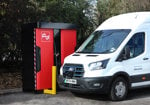Even the country’s most proactive fleets in terms of managing the safety of their drivers are failing in several key areas, according to a new Government study.
While the study found that fleets of just five vehicles can benefit as much from driver training and road risk management initiatives as a fleet of 10,000 vehicles, it also discovered that the best performers were still failing to address major at-work driver safety issues.
The research on business driver safety, which has just been published by the Department for Transport, found there were very few significant differences between small fleets and their larger contemporaries when it comes to managing their drivers’ safety.
Where significant differences were found, the results always indicated better practices in small or medium-sized, rather than large organisations.
“This finding may come as a surprise when considering that larger organisations are more likely to have dedicated posts for the management of health and safety-related matters,” said the authors.
“Size does not matter – there are many examples of SMEs who manage their safety very well – and big organisations; similarly there are many examples of big organisations that manage their driver safety poorly, and small organisations,” added Dr Will Murray of Interactive Driving Systems.
“Contracting and sub-contracting is also an important issue here – large organisations that use smaller contractors and sub-contractors should build safe driving into their tendering process.”
Paul Gallemore, Wolseley’s European head of safety, added: “The size of the fleet should not influence or impact how effective driver safety management can be. Whether an organisation has 250 vehicles or 2,500 - robust processes should be in place regardless.
"We all have the same duty of care for our employees.
"Factors which have more of a bearing on the effectiveness of driver safety management include the available fleet management resource, the experience and capabilities of the health and safety practitioners and the drivers themselves, the culture of the organisation and ‘buy-in’ of fleet safety across all levels of the business.”
However, the research findings, which are published in the Behavioural Research in Road Safety 2007 Seventeenth Seminar document, relied on a self-selected sample of organisations that put themselves forward for participation in the study.
“These stakeholders were most likely individuals or organisations that…had already recognised a need to improve performance in the area of managing work-related road risk.”
However, the study found that despite the ‘best of the best’ putting themselves forward, there were very few cases of a fully encompassing approach to managing driver safety.
“Many organisations have some systems in place, but a comprehensive coverage of all relevant areas is exceptional,” it found. “Important areas, such as pre-employment assessments, monitoring of medical conditions, non-managed use of privately-owned vehicles for work, effective measures to guard against substance misuse or mobile-phone use, are rarely in place.”
The report said it was concerning that, even though it studied proactive fleets, gaps in their safety policies were so obvious that further action was needed.
“When considering that the sample involved in the study is, in all likelihood, biased in terms of performing better at managing work-related road safety than the majority of organisations in Great Britain, the need for further action becomes clear.”
It found for example that transport managers in local authorities “revealed that they typically did not know the number of privately-owned vehicles in their council” that were being used for business purposes.
“Even the best organisations could do better – in our audits of fleet safety there are almost always gaps – even in the better organisations.
"Typically good organisations manage themselves and sometimes their contractors well – but less so their sub-contractors, grey fleet or family members driving company vehicles.
"Many other good organisations manage their commercial/liveried fleet well, but not their company cars so well,” added Dr Murray.
“www.fleetsafetybenchmarking.net which is a free Department for Transport-funded project, is a good starting point to identify gaps, benchmarks and areas for improvement.”
Gallemore added: “There are still gaps in the policies of the best fleets when it comes to addressing driver safety.
"However to help address this issue, Wolseley regularly shares ideas and best practice with other organisations who are equally committed to improving fleet safety and reducing collision rates.
"For example, we have introduced initiatives which focus on the driver, the vehicle and the journey, such as online driver risk assessments, ‘Safe Driver of the Year’ competitions, and safe driving handbooks – and have shared these with other operators.”
















Login to comment
Comments
No comments have been made yet.